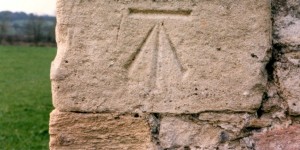A little over two miles northwest of Oxford, the tiny hamlet of Godstow lies alongside the River Thames. Bucolic in its landscape, Godstow remains noteworthy for two of its area landmarks, a medieval nunnery and The Trout (Inn, Pub) which 850 years ago(give or take), served as the nunnery’s 12th century hospice. Sadly the years have not been kind to what was once an extremely wealthy nunnery, as the ruins are now scant. Nevertheless, Godstow has held a fascination for me since the first time I walked its grounds nearly 35 years ago and why I’ve chosen it for the setting of my next historical mystery which is in the works, “A Watch of Nightingales.”
One of the better known reasons for the nunnery’s high profile is that Godstow is where Henry II’s famous mistress, the “fair Rosamund Clifford” was buried upon her death in 1175(1174 or 1176 depending on which ‘authority’ one reads). While some sources claim the fair Rosamund died of natural causes, there are myths pointing to Henry’s artfully scheming queen, Eleanor of Aquitaine, as Rosamund’s murderess…a charge which Eleanor consistently denied…vehemently.
Leaving Henry, Eleanor and Rosamund aside for the moment, the remaining stones of Godstow surely protect many other secrets, sending the imagination into the realms of ‘what if’? Scholars cite the existence of ‘outrageous lascivious and licentious behavior’ between the nuns, clerks and scholars of Oxford. Given that Godstow was built on a marsh island across the river from the Trout, how did they get into town, as it were? And what sort of intrigues were behind these nocturnal assignations, not to mention that Godstow’s meadow and ditches were and still are, abundant with Birthwort, an herb used in childbirth and…as an abortive.
In 2006, The Oxford Times ran an article reporting that in 1944, children playing by the Godstow river bank discovered a stone coffin lodged under the tow path, its lid resting about six inches above water level. Further inspection revealed bones of an adult female. This coffin was the first of several that have ‘appeared’ over the years, which then disappear into the riverbed, divers unable to locate further evidence of their existence.
Several years ago I discovered a fascinating symbol carved in the remaining stones of Godstow. Eerily similar to symbolism used by ancient and modern Druids, research efforts to discover its meaning and source over the years remain elusive. Disappointingly, it could very well be the work of 21st century graffiti artists or ritualists. Nevertheless, I prefer to remain mystified…it makes for good plotting in an historical mystery.
Photography©2012 Gaye F. Mack, Inc.


What you spotted is a benchmark long used by the Ordnance Survey to record height above sea level. They can be seen on all sorts of permanent structures – buildings, bridges etc Once you become aware of them you may start to notice their unobtrusive but ubiquitous presence.
See here https://en.wikipedia.org/wiki/Benchmark_(surveying)
Thanks Natasha…yes I’ve been told this by others…certainly interesting!